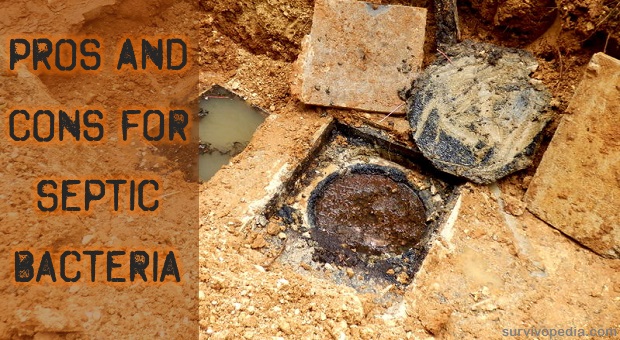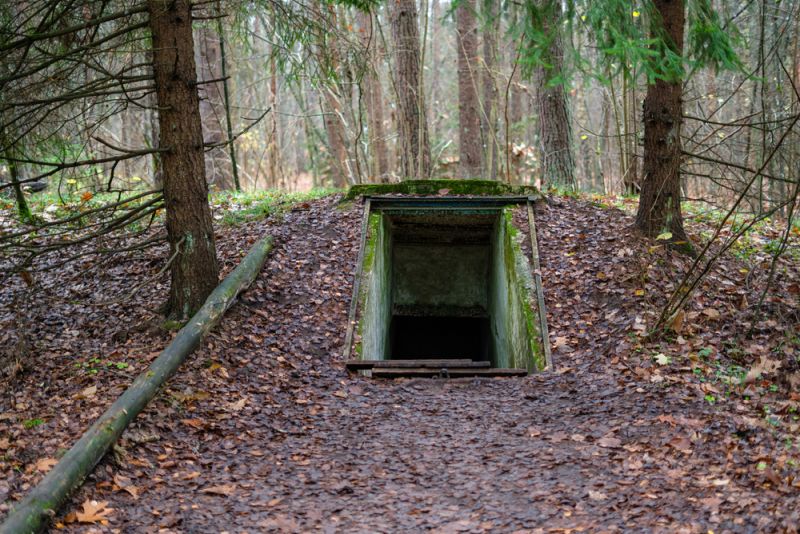Septic tanks are becoming increasingly popular in the United States.
That’s because building a septic tank is way cheaper than installing a regular sewer system (and equally efficient and sanitary if built and maintained properly).
Thus a septic tank can be regarded as your own personal water sewage treatment system. But is there any special treatment that you should apply in order to prolong its life? And are the septic bacteria a part of this treatment?
Around 25% of total housing in the US and over 33% of newly built residences are using onsite septic systems. The trend is very clear, so you should learn a few things about this issue.
To put it simply, a septic system consists of a large steel or concrete tank buried in your back yard. Usually, a septic tank can hold 4k liters of water or one thousand gallons. Its actual size is determined by the number of people that are using it or the size of the house, obviously. The more, the merrier and the bigger the septic tank must be.
How does a septic tank work? Well, the waste water from your residence enters the septic tank via the sewer pipes from the home at one end of the tank and exits the tank at the other end. Since it drains into the ground, a septic tank requires a relatively large septic drain field.
During transit, the waste water is treated and purified. Most modern septic tanks have two compartments. In the first compartment, the solid matter is allowed to settle at the bottom of the tank while the scum floats. The solid waste is later digested by the anaerobic bacteria in the tank. In the second chamber, further settlement takes place and the relatively clean water is allowed to escape into the drain field.
Here’s where the word “septic” comes into play. Septic refers to the anaerobic bacteria that thrives inside of the tank and plays a crucial role in mineralizing/decomposing the waste that transits and settles at the bottom of the septic system.
How Bacteria Work
The main principle behind septic tanks is the natural bacterial action that decomposes our natural waste products and transforms them into environmentally “friendly” stuff that is later discharged to the onsite drain field.
Obviously, we can assert that without the trillions of naturally occurring bacteria that thrive inside a septic system, there would be no “action” there. These critters play a major part in the process that cleans the waste water in a septic system.
Actually, up to 50% of the sediments inside of a septic system are transformed into gases and liquids, i.e. they’re actually eaten, digested and excreted by the septic bacteria that live inside the tank.
Next, you must be aware of the fact that a conventional septic tank is not actually maintenance-free. Even if the bacteria is doing their job with flying colors, sludge (the undigested solid stuff) will start to build on the bottom of the tank and it must be pumped out from time to time. This usually needs done once every 4 years, depending on the size of the tank and the usage.
If not maintained properly, the sludge from inside the tank will leak out in the drain field, thus making it unsanitary.
Besides having your tank pumped regularly, one of the most important things to take care of in your septic tank is the ecosystem. By that, we mean the bacteria that lives inside must be spared from “ingesting” large amounts of household chemicals such as (non-bio degradable) detergents, bleach, solvents etc.
Basically, you should avoid “feeding” your septic bacteria toxic stuff like solvents (paint thinner), insecticides or anything else that may kill them (including large amounts of grease/cooking fats). If you destroy your good bacteria, your tank won’t drain properly, thus requiring frequent tank pumping which can become expensive quickly.
Pumping your septic system every 3-4 years is absolutely required and recommended by most professionals. There are about 1200 “septic system additives” on the market today and they claim to reduce the frequency of the “costly” pumping if using them as a regular-low cost quick fix.
There are a few things one must know about septic additives or septic bacteria before you dump them down the nearest drain or toilet:
- While they can’t do any harm to your septic system, there is actually no (as in ZERO to my knowledge) scientific proof that they’re actually doing something except for costing you money.
- There are a few American Court Cases that involve the fraudulent sale of septic tank products that claimed that their products make septic tank pumping completely unnecessary.
- In a properly functioning, well-maintained septic tank, all the bacteria required comes from the human waste itself, given that you don’t use harsh chemicals or lots of anti-bacterial products.
Anyway, even if you choose to buy septic bacteria additives, if you don’t follow the rules i.e. you keep killing the friendly critters with your harsh chemicals, you’ll also kill the “guns for hire” bacteria (that you PAID for).
How to Make Your Own Bacteria Activator
Even if septic bacteria additives are not scientifically proven to reduce or eliminate the need for pumping your septic tank on regular basis, a freshly pumped septic tank can benefit from a helping hand.
By that, we’re referring to seeding a newly-pumped septic tank with the necessary bacteria that will actually start eating the solid stuff in the waste water. Because, after you pump out the tank, most of the beneficial/septic bacteria are also banished.
Hence, it is recommended to add some DIY (Do It Yourself) bacteria activator.
The recipe for a DIY septic bacteria activator:
- 2 packs of active dry yeast
- 4 cups of brown sugar
- 4 cups of hot (but not too hot) water
The mixture should be put inside of a bucket, dissolved/stirred, then left alone for 15-20 minutes (the yeast will react with the sugar and it will get frothy). Once that happens, flush the stuff down your toilet in a few batches instead of all at once. The best time for using the “activator” is at night when everyone is sleeping in order to give the “treatment” time to do its job.
You can use this stuff regularly, once every few months, for “maintenance” purposes, it will cost you next to nothing and it will keep the septic bacteria inside the tank happy and thriving.
Another DIY method for keeping the good bacteria and the enzymes in good shape is to use rotten tomatoes. Yes, you got that right.
Every 2-3 months, feed your septic tank 3-4 rotten tomatoes via your garbage disposal while the water is running, your septic system will work very well and for extended periods of time. You must make sure that you only pass half a tomato at a time so it breaks up completely into the garbage disposal system.
If you don’t have a garbage disposal system, you can just put the rotten tomatoes in a bag, squash them to small chunks and then flush them down the toilet.
To keep your septic tank in good shape, you should keep meat from getting in there via the garbage disposal system; meat doesn’t contain beneficial bacteria, either raw or cooked. Also avoid flushing baby wipers, feminine hygiene products, and paper towels and so on and so forth. You should only flush toilet paper and human waste, even if the other “stuff” claims to be “safe” for your septic tank, it actually takes ages to break down.
You should also know that the cleaner the home, the more dead the septic tank is. This doesn’t mean that you should stop taking care of your home; au contraire.
All you have to do is avoid using (or minimize the use of) strong cleaning chemicals (bleach-chlorine) and opt out for biodegradable home care and personal hygiene products.
This article has been written by Chris Black for Survivopedia.










Courtney Millburn | November 13, 2014
|
My wife uses the yeast treatment on our septic system about quarterly. It works. One of the reasons for the additional treatment is that we use anti-bacterial soap for handwashing, etc. She also buys septic safe toilet paper and we don’t scrap food into the waste stream – it either goes into the trash or the compost.
James Cooke | November 13, 2014
|
Hey, Chris! Thank you, thank you, thank you! A very well written article. And interesting to boot! I am eagerly looking forward to more from your pen. (from a new prepper)
Mike Murehead | November 13, 2014
|
I heard many years ago to add butter milk to the septic tank every 6 months or so. I’ve been doing this and my tank hasn’t needed pumping in over 8 years. We are careful to not flush harsh chemicals and heavy paper products. (Except for my chili can be pretty harsh sometimes.;)
Earl Anderson | November 13, 2014
|
I live off-grid with a septic system. Only toilets go into the septic system the rest (sinks, tubs, showers) are on a gray water system to use the water for gardening.
One issue with the above article yeasts are part of the Fungi Kingdom and aren’t bacteria. He does have it right that they will work to digest wastes.
Doc | November 13, 2014
|
Good information. One question – would this be a good treatment idea for a lagoon system?
sCOTT | November 14, 2014
|
I work in the septic industry. I agree with much of what the author has to say, but I disagree that bacterial additives should be ignored. The trick is to get the right additives. In my experience; the expensive, store bought additives such as Rid-X are not good investments. They contain arobic bacteria, which do little to break down septic waste. What you end up with is a thick layer of organic waste that can get thick enough to block the outlet to your drainfield.
What you want to be looking for is Anirobic bacteria, and make sure the product contains live bacteria. I also agree that pumping your septic system at least once every three years. This prevents the sludge on the bottom from building up. Believe me, a septic tank that is pumped every couple of years is much easier to clean then one that has gone untouched for five or ten years. It’s cheaper in the long run as well. A neglected tank will require the pumper to return in three to six months to pump it again because he was unable to get all the sludge off the bottom. It sucks, but that’s what happens.
Another thing to note. Have a good diagram of where your tank is actually located before the pumper arrives. Nothing irritates a septic pumper more then having to find your tank because you have no idea where it is. And if it is buried more then a foot below ground, dig it up prior to the driver’s arrival. Most drivers will not dig the access hatch up for you. Or, if they do, it’s gonna cost you. And since the going rate is usually upwards of $50 to $100/hour, you don’t want them to be spending any more time at your tank then absolutely necessary.
Pingback:PROs And CONs For Septic Bacteria | November 15, 2014
|
Pingback:PROs And CONs For Septic Bacteria | TheSurvivalPlaceBlog | November 16, 2014
|
Pingback:Off-The-Grid Hygiene Guide | Survival skills, survival guns, survival guide | January 14, 2015
|
Pingback:Off The Grid Hygiene Guide - Bio Prepper | February 12, 2015
|
Pingback:3 Crucial Steps When Digging A Well | Survival skills, survival guns, survival guide | April 22, 2015
|
Pingback:Off-The-Grid Hygiene Guide - US Crisis PreppersUS Crisis Preppers | June 16, 2015
|
Pingback:Rural Bugging In: 10 Problems And How To Solve Them | | disasterdefense.us | February 3, 2016
|
Silas Knight | April 22, 2016
|
I had no idea that septic tank use was growing so rapidly. We don’t have one, but I can see how it would be nice to have one installed. The infographic you have here is really interesting, I wonder why 46% of septic systems are in the South?
Pingback:22 Ways To Use Baking Soda For Your Homestead | | disasterdefense.us | May 4, 2016
|
Doug | July 24, 2016
|
These two sentences sound contradictory to me: 1) “…septic bacteria additives are not scientifically proven…”, and 2) “seeding a newly-pumped septic tank with the necessary bacteria that will actually start eating the solid stuff….” Why would you rail against something that isn’t proven in one sentence, and then do recommend doing it via a home-based remedy? If it doesn’t work, why do it?
Jat | November 28, 2016
|
My understanding of that is, if you have a well functioning system the bacteria are repopulating themselves and adding more is of little to no consequence. It won’t hurt but isn’t proven to help either. However if you have the tank pumped and with it goes your little critters you have to establish a new population and that’s where your additives ( commercial or homemade) become necessary. Once up and going again, I assume no further additions are needed.
John Mahoney | February 13, 2017
|
I didn’t know that septic tanks could usually hold about a thousand gallons. It makes sense that knowing these details can help you find out what the best way to maintain it is. I would want to make sure I call in the pros to help me get the most out of my system and that help me understand how to care for it.
Colleen | April 1, 2018
|
My mother-in-law always used the yeast and brown sugar treatment in the out house at the cabin in British Columbia – when she became too ill to go up there she asked me to take care of ‘things’ as she had taught me. We NEVER have had to move the outhouse in all the years we have had the cabin using her method of treatment (50+!!) because the waste breaks down so well it isn’t necessary! If it works that well for an outhouse it will work for a septic system, too!
Pingback:Rural Bugging In: 10 Problems And How To Solve Them | Survivopedia | September 5, 2018
|
Malia Davis | November 2, 2018
|
I’m glad the infographic mentioned that pumping your septic tank every 3-5 years is the only way to keep it clean. We just moved into this home, but it seems like our septic tank hasn’t been pumped in at least 6 years. We better get a professional out here to take a look at it so that the system runs efficiently. Thanks for making us aware of this!
Penelope Smith | December 4, 2018
|
I have never had to take care of a septic system before. It is good to know that I needed to maintain my system. That is great for me to know because I did think that the system would take care of itself. It might be smart for me to get a professional to come to take a look at my system soon.